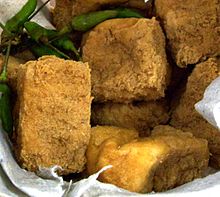 | |
| Alternative names | Tahu bunkeng |
|---|---|
| Place of origin | Indonesia |
| Region or state | Sumedang Regency, West Java |
| Main ingredients | Deep-fried tofu |
Tahu sumedang or Tahu bunkeng (Sumedangite tofu, bunkeng tofu) is a Sundanese deep-fried tofu from Sumedang, West Java, Indonesia.